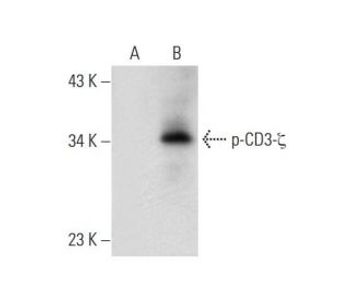
p-CD3-ζ (C415.9A) Alexa Fluor® 680 | Santa Cruz Biotechnology
mouse monoclonal IgG1; p-CD3-ζ Antibody (C415.9A) is an IgG1 κ mouse monoclonal p-CD3-zeta antibody (also designated CD247 antibody, or CD3 zeta antibody) that detects the p-CD3-zeta protein of human origin by WB, IP, FCM and ELISA. p-CD3-ζ Antibody (C415.9A) is available as both the non-conjugated anti-p-CD3-zeta antibody form, as well as multiple conjugated forms of anti-p-CD3-zeta antibody, including agarose, HRP, PE, FITC and multiple Alexa Fluor® conjugates. The T cell antigen receptor (TCR) recognizes foreign antigens and translates such recognition events intointracellular signals that elicit a change in the cell from a dormant to an activated state. Much of this signaling process can be attributed to a multisubunit complex of proteins that associates directly with the TCR. This complex has been designated CD3 (Cluster of Differentiation 3). It is composed of five invariant polypeptide chains that associate to form three dimers: a heterodimer of gamma and epsilon chains (ge), a heterodimer of delta and epsilon chains (δε) and a homodimer of two zeta chains (ζζ) or a heterodimer of zeta and eta chains (ζh) (2-4). The zeta and eta chains are encoded by the same gene but differ in their carboxyl-terminal ends due to an alternative splicing event. The gamma, epsilon and delta chains each contain a single copy of a conserved immunoreceptor tyrosine-based activation motif (ITAM). In contrast, the zeta chain contains three consecutive copies of the same motif. Phosphorylated ITAMs act as docking sites for protein kinases such as ZAP-70 and Syk and are also capable of regulating their kinase activity. The crystal structure of ZAP-70's SH2 domains bound to the zeta chain ITAMs has been solved.

























































